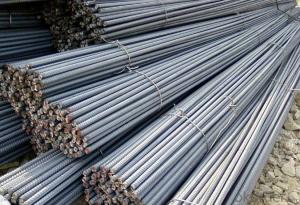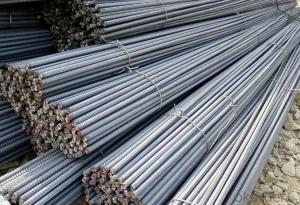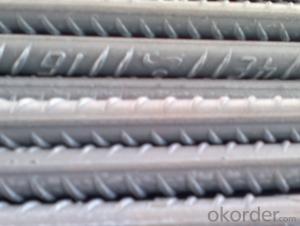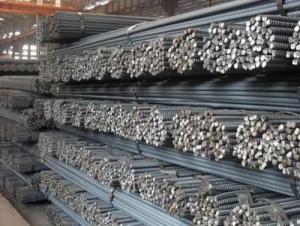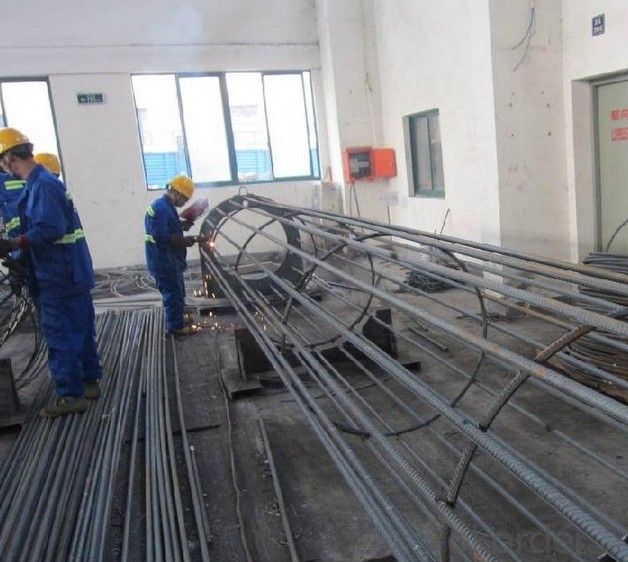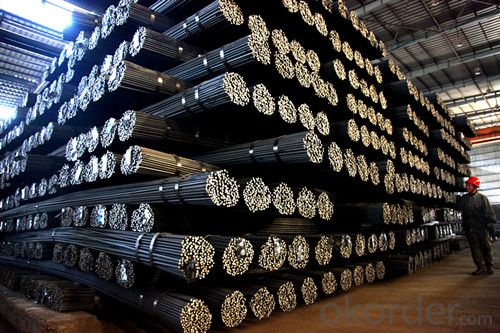High quality hot rolled deformed bar 6mm-50mm ASTM ou BS4449
- Loading Port:
- Tianjin
- Payment Terms:
- TT OR LC
- Min Order Qty:
- 25 m.t.
- Supply Capability:
- 20000000 m.t./month
OKorder Service Pledge
OKorder Financial Service
You Might Also Like
Deformed Bar Details:Product Description:Specifications of HRB400 Deformed Steel Bar:StandardGBHRB400Diameter6mm,8mm,10mm,12mm,14mm,16mm,18mm,20mm,22mm,25mm,28mm,32mm,36mm,40mm,50mmLength6M, 9M,12M or as requiredPlace of originHebei, China mainlandAdvantagesexact size, regular package, chemical and mechanical properties are stable.TypeHot rolled deformed steel barBrand nameDRAGON Chemical Composition: (Please kindly find our chemistry of our material based on HRB500 as below for your information) GradeTechnical data of the original chemical composition (%)CMnSiSPVHRB400≤0.25≤1.60≤0.80≤0.045≤0.0450.04-0.12Physical capabilityYield Strength (N/cm²)Tensile Strength (N/cm²)Elongation (%)≥400≥570≥14 Theoretical weight and section area of each diameter as below for your information: Diameter(mm)Section area (mm²)Mass(kg/m)Weight of 12m bar(kg)628.270.2222.664850.270.3954.741078.540.6177.40412113.10.88810.65614153.91.2114.5216201.11.5818.9618254.52.002420314.22.4729.6422380.12.9835.7625490.93.8546.228615.84.8357.9632804.26.3175.723610187.9998.884012579.87118.4450196415.42185.04 Usage and Applications of HRB400 Deformed Steel Bar: Deformed bar is widely used in buildings, bridges, roads and other engineering construction. Big to highways, railways, bridges, culverts, tunnels, public facilities such as flood control, dam, small to housing construction, beam, column, wall and the foundation of the plate, deformed bar is an integral structure material. With the development of world economy and the vigorous development of infrastructure construction, real estate, the demand for deformed bar will be larger and larger.. Packaging & Delivery of HRB400 Deformed Steel Bar: Packaging Detail: products are packed in bundle and then shipped by container or bulk vessel, deformed bar is usually naked strapping delivery, when storing, please pay attention to moisture proof. The performance of rust will produce adverse effect. Each bundle weight: 2-3MT, or as required Payment term: TT or L/C Delivery Detail: within 45 days after received advanced payment or LC. Label: to be specified by customer, generally, each bundle has 1-2 labels Trade terms: FOB, CFR, CIF
|
- Q:How do steel rebars affect the overall fire rating of a building?
- Steel rebars can have a positive impact on the overall fire rating of a building. By reinforcing concrete structures, rebars can help enhance the fire resistance of the building. Steel has high melting and ignition temperatures, which means it can withstand heat and maintain its structural integrity for longer periods during a fire. This additional durability provided by rebars can help prevent structural collapse, allowing occupants more time to evacuate safely and aiding firefighters in their efforts to suppress the fire.
- Q:What are the factors that determine the spacing of steel rebars in a concrete structure?
- The spacing of steel rebars in a concrete structure relies on various factors that guarantee the concrete's structural integrity and strength. These factors encompass: 1. Structural Design: The spacing of rebars is influenced by the structural design requisites and specifications of the concrete structure. Engineers take into account the loads, stresses, and forces that the structure will endure and compute the necessary reinforcement spacing accordingly. 2. Concrete Strength: The concrete's strength used in the structure is a pivotal determinant in establishing rebar spacing. Higher-strength concrete may necessitate closer spacing of rebars to provide ample reinforcement and prevent cracking or failure under load. 3. Rebar Diameter: The diameter of the steel rebars also contributes to determining the spacing. Thicker or larger diameter rebars may require wider spacing, while thinner rebars typically necessitate closer spacing to deliver the desired reinforcement. 4. Bar Bending and Placing: The ease of bending and placing the rebars during construction is another crucial factor. Often, practical considerations dictate the spacing, such as guaranteeing proper access for workers and equipment and facilitating the concrete pouring process. 5. Environmental Factors: Environmental conditions, including exposure to corrosive substances or extreme weather conditions, can impact rebar spacing. Closer spacing may be necessary in corrosive environments to provide additional protection against rust and deterioration. 6. Building Codes and Regulations: Local authorities or relevant organizations establish building codes and regulations that set the minimum requirements for rebar spacing in concrete structures. These codes ensure compliance with safety standards and offer guidelines for construction practices. In conclusion, the spacing of steel rebars in a concrete structure is a crucial aspect in ensuring its strength, durability, and resilience. It relies on a combination of factors, including structural design, concrete strength, rebar diameter, construction practicalities, environmental considerations, and adherence to building codes and regulations.
- Q:How do steel rebars affect the overall weight of a concrete structure?
- Steel rebars typically increase the overall weight of a concrete structure. This is because steel rebars add additional mass to the concrete, making it heavier. However, the weight increase is generally proportionate to the added strength and durability that the rebars provide, making them essential for reinforcing the structure and improving its structural integrity.
- Q:How are steel rebars different from other types of reinforcement?
- Steel rebars, also known as reinforcing bars, are different from other types of reinforcement primarily due to their composition and strength. Unlike other types of reinforcement such as fiberglass or carbon fiber, steel rebars are made of steel, which gives them exceptional strength and durability. One of the key differences between steel rebars and other types of reinforcement is their ability to withstand high tensile forces. Steel has a high tensile strength, meaning it can resist being stretched or pulled apart. This makes steel rebars ideal for reinforcing concrete structures that are subjected to significant tensile loads, such as bridges, buildings, and highways. Another distinguishing feature of steel rebars is their ability to bond well with concrete. The ridges or deformations on the surface of rebars provide better adhesion between the steel and concrete, allowing for efficient load transfer. This bond ensures that the concrete and steel work together as a composite material, enhancing the overall strength and structural integrity of the reinforced concrete structure. Steel rebars also offer versatility in terms of shape and size. They are available in various diameters, lengths, and shapes, including round, square, and deformed. This allows engineers to choose the most appropriate type of rebar based on the specific requirements of the construction project. Additionally, steel rebars are highly resistant to corrosion, especially when they are properly coated or protected. This resistance to corrosion ensures the longevity and durability of the reinforced concrete structure, even in harsh environments or exposure to moisture. In summary, steel rebars differ from other types of reinforcement due to their exceptional strength, ability to withstand high tensile forces, excellent bond with concrete, versatility in shape and size, and resistance to corrosion. These qualities make steel rebars the most commonly used and preferred choice for reinforcing concrete structures in the construction industry.
- Q:What are the maintenance requirements for steel rebars in a structure?
- To ensure the stability and longevity of a building, it is crucial to consider the maintenance requirements for steel rebars in its structure. Steel rebars, also referred to as reinforcing bars, are utilized to strengthen concrete structures and withstand tension forces. Here are some important maintenance requirements to bear in mind: 1. Conducting Visual Inspections: Qualified personnel with knowledge and experience in recognizing structural issues should regularly perform visual inspections to identify any signs of corrosion, cracks, or damage in the rebars. 2. Keeping the Rebars Clean: It is necessary to keep the rebars free from debris, dirt, or chemicals that could accelerate corrosion. Employing proper cleaning methods, such as mild detergents and water, is essential to maintain their condition. 3. Protecting Against Corrosion: Steel rebars are prone to corrosion, particularly in environments with high humidity, exposure to saltwater, or chemical pollutants. Applying protective coatings like epoxy or zinc can help prevent or delay corrosion, thereby increasing the lifespan of the rebars. 4. Prompt Repair or Replacement: In the event of severe corrosion, cracks, or damage to any rebars, it is crucial to promptly repair or replace them. Neglecting these issues can compromise the structural integrity of the building and pose safety hazards. 5. Continuous Monitoring: It is advisable to continuously monitor the condition of the rebars to detect any changes or deterioration over time. Advanced techniques such as ultrasonic testing or electrical potential measurements can be utilized to assess the rebars' integrity. 6. Ensuring Proper Drainage: The structure should have proper drainage systems in place to prevent water accumulation and reduce the risk of corrosion in the rebars. Well-designed and well-maintained gutters, downspouts, and waterproofing measures can minimize water exposure. 7. Establishing a Regular Maintenance Schedule: It is crucial to establish a regular maintenance schedule to systematically conduct all necessary inspections, cleaning, and repairs. This aids in early identification of potential issues and enables prompt corrective actions. By adhering to these maintenance requirements, the steel rebars in a structure can be preserved, contributing to the overall safety, durability, and longevity of the building. Regular maintenance not only prevents costly repairs but also ensures the necessary structural integrity for the safety of occupants and the longevity of the structure.
- Q:Can steel rebars be used in precast concrete applications?
- Yes, steel rebars can be used in precast concrete applications. Precast concrete refers to a construction method where concrete elements, such as walls, slabs, or beams, are cast in a controlled environment before being transported to the construction site for installation. Steel rebars, which are typically made of carbon steel and have ribs on their surface to provide better adhesion to the concrete, are commonly used to reinforce precast concrete elements. The use of steel rebars in precast concrete applications offers several advantages. Firstly, the presence of rebars helps to increase the overall strength and durability of the precast concrete elements, making them capable of withstanding higher loads and reducing the risk of structural failure. Additionally, rebars also enhance the resistance of the precast elements to cracking and shrinkage, ensuring better long-term performance. Moreover, steel rebars facilitate the proper transfer of tensile forces within the precast concrete elements. While concrete has excellent compressive strength, it is relatively weak in tension. By incorporating rebars into the precast elements, the tensile forces generated during service can be effectively absorbed by the rebars, preventing cracks and ensuring the structural integrity of the element. Furthermore, steel rebars offer flexibility in design and construction. Precast concrete elements can be manufactured in a wide range of shapes and sizes to meet specific project requirements, and the inclusion of rebars allows for greater design freedom. It enables the creation of complex and intricate precast elements that can be customized to fit various architectural and structural designs. In conclusion, steel rebars are essential components in precast concrete applications. Their inclusion significantly enhances the strength, durability, and performance of precast concrete elements. With the ability to resist tensile forces and provide structural integrity, steel rebars play a vital role in ensuring the safety and longevity of precast concrete structures.
- Q:What is the impact of steel rebars on the constructability of a project?
- Steel rebars have a significant impact on the constructability of a project. They provide strength and stability to reinforced concrete structures, enhancing their durability and load-bearing capacity. By reinforcing concrete, steel rebars enable the construction of taller and more complex structures. Additionally, rebars also facilitate efficient construction processes, such as faster concrete pouring and reduced formwork requirements. Overall, the presence of steel rebars greatly improves the constructability and long-term performance of a project.
- Q:Are steel rebars suitable for use in structures with aggressive soil conditions?
- Yes, steel rebars are suitable for use in structures with aggressive soil conditions. Steel rebars have excellent strength and durability, making them resistant to the corrosive effects of aggressive soil. Additionally, rebars can be coated with protective materials or used in conjunction with other corrosion-resistant techniques to enhance their performance in such conditions.
- Q:Can steel rebars be used in bridges and highways?
- Yes, steel rebars can be used in bridges and highways. Steel rebars provide strength and durability to structures, making them suitable for use in the construction of bridges and highways.
- Q:Can steel rebars be used in precast concrete walls?
- Yes, steel rebars can be used in precast concrete walls. In fact, they are commonly used to reinforce the concrete and provide strength and durability to the structure. The rebars are typically placed within the precast panels during the manufacturing process to enhance their load-bearing capacity and resistance to cracking or breaking.
1. Manufacturer Overview |
|
|---|---|
| Location | |
| Year Established | |
| Annual Output Value | |
| Main Markets | |
| Company Certifications | |
2. Manufacturer Certificates |
|
|---|---|
| a) Certification Name | |
| Range | |
| Reference | |
| Validity Period | |
3. Manufacturer Capability |
|
|---|---|
| a)Trade Capacity | |
| Nearest Port | |
| Export Percentage | |
| No.of Employees in Trade Department | |
| Language Spoken: | |
| b)Factory Information | |
| Factory Size: | |
| No. of Production Lines | |
| Contract Manufacturing | |
| Product Price Range | |
Send your message to us
High quality hot rolled deformed bar 6mm-50mm ASTM ou BS4449
- Loading Port:
- Tianjin
- Payment Terms:
- TT OR LC
- Min Order Qty:
- 25 m.t.
- Supply Capability:
- 20000000 m.t./month
OKorder Service Pledge
OKorder Financial Service
Similar products
New products
Hot products
Hot Searches
Related keywords
